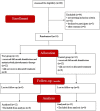The effect of antimicrobial photodynamic therapy on periodontal disease and glycemic control in patients with type 2 diabetes mellitus
- PMID: 37672083
- PMCID: PMC10560165
- DOI: 10.1007/s00784-023-05239-0
The effect of antimicrobial photodynamic therapy on periodontal disease and glycemic control in patients with type 2 diabetes mellitus
Abstract
Objectives: This study is aimed at determining the effect of concomitant antimicrobial photodynamic therapy (aPTD) on periodontal disease and glycaemic control in patients with type 2 diabetes mellitus (T2DM).
Materials and methods: Twenty-four patients with T2DM were enrolled in the study. Periodontal clinical parameters were assessed by measuring probing pocket depth (PPD), clinical attachment loss (CAL), gingival recession (GR), full-mouth bleeding score (FMBS), full-mouth plaque score (FMPS), and full-mouth sulcus bleeding score (FMSBS). Glycated haemoglobin A1c (HbA1c) was measured. To determine the presence of the following periodontal pathogenic bacteria, Aggregatibacter actinomycetemcomitans, Prevotella intermedia, Porphyromonas gingivalis, Tannerella forsythia, and Treponema denticola, subgingival plaque samples were taken from two periodontal pockets per jaw with the greatest PPD using paper tips. Patients were randomly divided into the test and control group. In the test group, full-mouth disinfection was performed in combination with aPTD. In the control group, only full-mouth disinfection was performed.
Results: The results showed an improvement in periodontal clinical parameters in both groups. The difference between the groups in favour of the test group was statistically significant for BOP. The HbA1c level decreased in both groups. The difference was not statistically significant. The results of the microbiological analysis suggest that the presence of periodontal pathogenic bacteria is lower with additional antimicrobial photodynamic therapy with statistically significant difference for T. forsythia.
Conclusions: Additional aPDT causes a significant reduction in BoP in the proportion of positive sites for periodontal pathogens.
Trial registration: ClinicalTrials.gov ID: NCT05816941.
Clinical relevance: aPTD is a noninvasive adjunctive therapy that can positively influence the periodontal treatment outcome.
Keywords: Antimicrobial photodynamic therapy; Indocyanine green; Periodontal disease; Type 2 diabetes mellitus.
© 2023. The Author(s).
Conflict of interest statement
The authors declare no competing interests.
The authors declare no competing interests.
Figures



Similar articles
-
Efficacy of Antimicrobial Photodynamic Therapy for Treating Moderate to Deep Periodontal Pockets in Individuals with Type 2 Diabetes Mellitus: A Systematic Review and Meta-Analysis.Dent J (Basel). 2025 Jan 2;13(1):21. doi: 10.3390/dj13010021. Dent J (Basel). 2025. PMID: 39851597 Free PMC article. Review.
-
Photodynamic therapy as adjunct to non-surgical periodontal treatment in patients on periodontal maintenance: a randomized controlled clinical trial.Lasers Med Sci. 2009 Sep;24(5):681-8. doi: 10.1007/s10103-008-0565-z. Epub 2008 May 9. Lasers Med Sci. 2009. PMID: 18465191 Clinical Trial.
-
Indocyanine-mediated antimicrobial photodynamic therapy promotes superior clinical effects in stage III and grade C chronic periodontitis among controlled and uncontrolled diabetes mellitus: A randomized controlled clinical trial.Photodiagnosis Photodyn Ther. 2021 Sep;35:102379. doi: 10.1016/j.pdpdt.2021.102379. Epub 2021 Jun 1. Photodiagnosis Photodyn Ther. 2021. PMID: 34087466 Clinical Trial.
-
Photodynamic therapy as an adjunct to non-surgical periodontal treatment: a randomized, controlled clinical trial.J Periodontol. 2008 Sep;79(9):1638-44. doi: 10.1902/jop.2008.070652. J Periodontol. 2008. PMID: 18771363 Clinical Trial.
-
Influence of periodontal surgery on the subgingival microbiome-A systematic review and meta-analysis.J Periodontal Res. 2023 Apr;58(2):308-324. doi: 10.1111/jre.13092. Epub 2023 Jan 4. J Periodontal Res. 2023. PMID: 36597817
Cited by
-
Does Non-surgical Periodontal Therapy With Adjunct Antimicrobial Photodynamic Therapy Help Reduce Periodontal Inflammation and Haemoglobin A1c Levels in Patients With Type-2 Diabetes Mellitus? A Systematic Review and Meta-analysis.Oral Health Prev Dent. 2024 Sep 17;22:479-486. doi: 10.3290/j.ohpd.b5750814. Oral Health Prev Dent. 2024. PMID: 39286965 Free PMC article.
-
The Adjunctive Role of Antimicrobial Photodynamic Therapy to Non-Surgical Treatment in Patients with Type 2 Diabetes Mellitus: A Systematic Review and Meta-Analysis.Healthcare (Basel). 2025 Jul 15;13(14):1703. doi: 10.3390/healthcare13141703. Healthcare (Basel). 2025. PMID: 40724728 Free PMC article. Review.
-
Oral Health Education in Patients with Diabetes: A Systematic Review.Healthcare (Basel). 2024 Apr 26;12(9):898. doi: 10.3390/healthcare12090898. Healthcare (Basel). 2024. PMID: 38727455 Free PMC article. Review.
-
Efficacy of Antimicrobial Photodynamic Therapy for Treating Moderate to Deep Periodontal Pockets in Individuals with Type 2 Diabetes Mellitus: A Systematic Review and Meta-Analysis.Dent J (Basel). 2025 Jan 2;13(1):21. doi: 10.3390/dj13010021. Dent J (Basel). 2025. PMID: 39851597 Free PMC article. Review.
-
Photodynamic therapy for the treatment of grade B periodontitis: a systematic review of randomized controlled trials.Lasers Med Sci. 2025 Jul 26;40(1):327. doi: 10.1007/s10103-025-04576-8. Lasers Med Sci. 2025. PMID: 40715926 Review.
References
-
- World Health Organization . Definition and diagnosis of diabetes mellitus and intermediate hyperglycemia, Report of WHO/IDF Consultation. Geneva, Switzerland: World Health Organization; 2006.
Publication types
MeSH terms
Substances
Associated data
LinkOut - more resources
Full Text Sources
Medical

